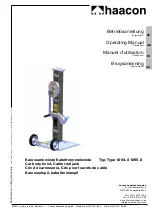
6
JACKING PRACTICES
(a) All mechanical jacks shall be used according to the manufacturer's recommendations.
(b) A plan should be developed and communicated to affected personnel before the jacking operation begins.
The plan should include load-handling procedures and communication methods.
(c) A piece of wood or other compressible material should be used between the jack load point and the load
surface to promote the mating of the two surfaces and to increase friction.
(d) Off-center loading of the primary load point should be avoided.
(e) When jacking, ensure that the load avoids contact with any obstructions.
(f) When jacking, ensure that the primary or auxiliary load point is properly positioned under the load to avoid
the jack from tipping over.
(g) When jacking one side or end of a load, ensure the opposing side or end is-stabilized with sufficient
blocking.
(h) When jacking a load, it should be raised in stages Jack one side or end, insert blocking, and lower the
load down to the blocking. Jack from the opposite side or end, insert blocking, and then lower down to
blocking.
Reverse this process when lowering the load.
(i) The jack handle, primary and auxiliary load points, and the jack base should be free of slippery material or
fluids.
(j) When jacking, a load should be raised or lowered in a limited range. Avoid jacking the side or end of the
load on more than a 3% grade.
(k) When lifting one side of an object with a high center of gravity, personnel should be on the side of the load
that is being lifted.
(l) After the raising or lowering operation is completed, remove the jack handle from the socket to avoid
accidental dislocation of the jack and to reduce the tripping hazard. (Excluding Farm Jacks and High Lift
Jacks)
(m) A load shall not be left unattended while supported by jacks. Blocking should be used to support
unattended loads.
(n) The load weight and center of gravity shall be determined prior to selecting and placing jacks and blocking.
(o) Before jacking a load, consideration shall be given to fluids or other shifting materials that can change the
location of the center of gravity.
(p) The base of the jack should be supported by a hard level surface (such as concrete, steel, or wood
blocking) capable of supporting the load.
(q) The force of the jack's load point should be placed or distributed to prevent damage to the load.
(r) A jack handle of the size and length specified by the manufacturer shall be used. Never use an over length
jack handle, extender, or "cheater pipe" over the handle.
(s) Ensure there is adequate range of motion for the jack handle to completely engage the operating linkage
of the jack.
Communication
(a) Communication between personnel involved in the lift operation shall be maintained continuously during all
jack movement. If at any time communication is disrupted, the jack operator(s) shall stop all movements
until communication is restored.
(b) Signals to the jack operator should be in accordance with the ASME B30.1. If special signals are required,
they shall be agreed upon by the load-handling personnel prior to jacking operations. Signals shall be
discernible or audible at all times. No action shall be taken unless signals are clearly under-stood.
(c) Jack operators shall obey any stop signal.
Synchronized Lifts
(a) When using jacks to lift the entire load in a synchronized lift, uneven raising and lowering can cause cross
loading, instability, and overloading.
(b) Some loads may require multiple lifting points and complex lifting procedures. A qualified person shall
analyze the operation and instruct all personnel involved in the proper selection and positioning of the
jacks and the movements to be made.
(c) When using multiple ratchet jacks simultaneously, ensure they are identical type (manufacturer, make,
model, and capacity), or lifting rate to ensure they are evenly loaded during jacking.
(d) Unsynchronized lowering can cause an overload to a jack and may result in kickback of tl1e jack handle or
instability of the load.



































